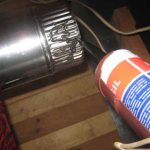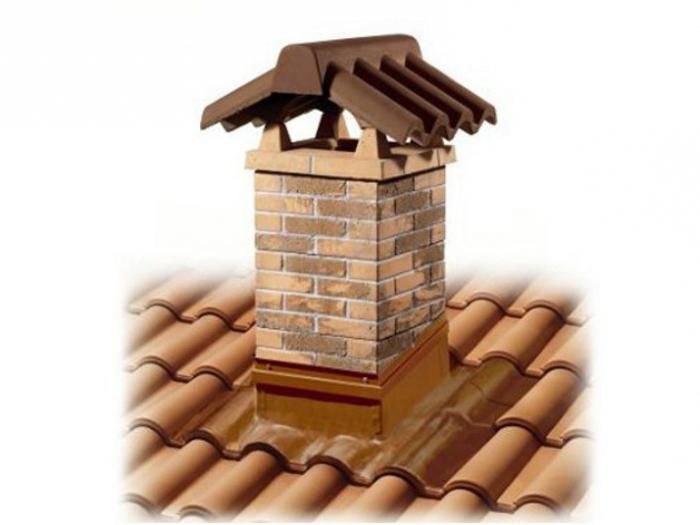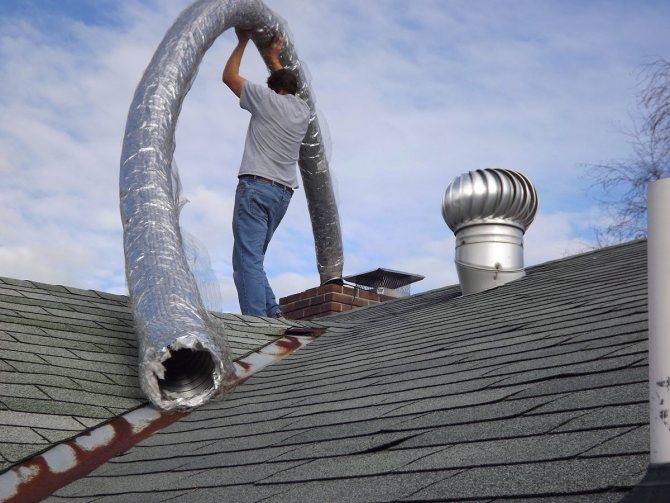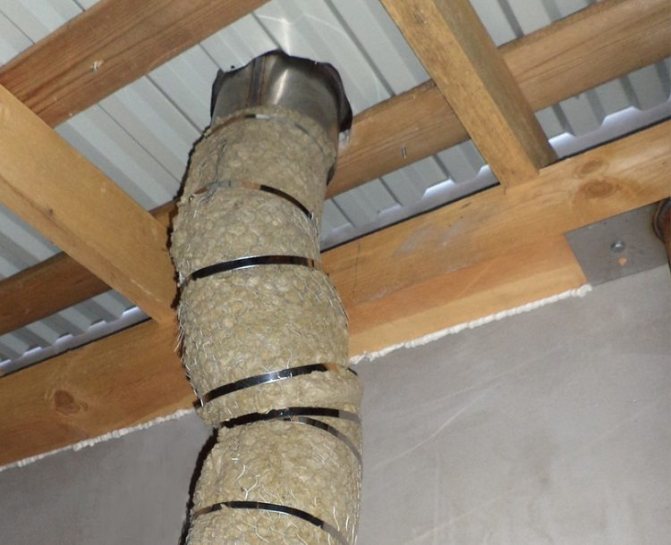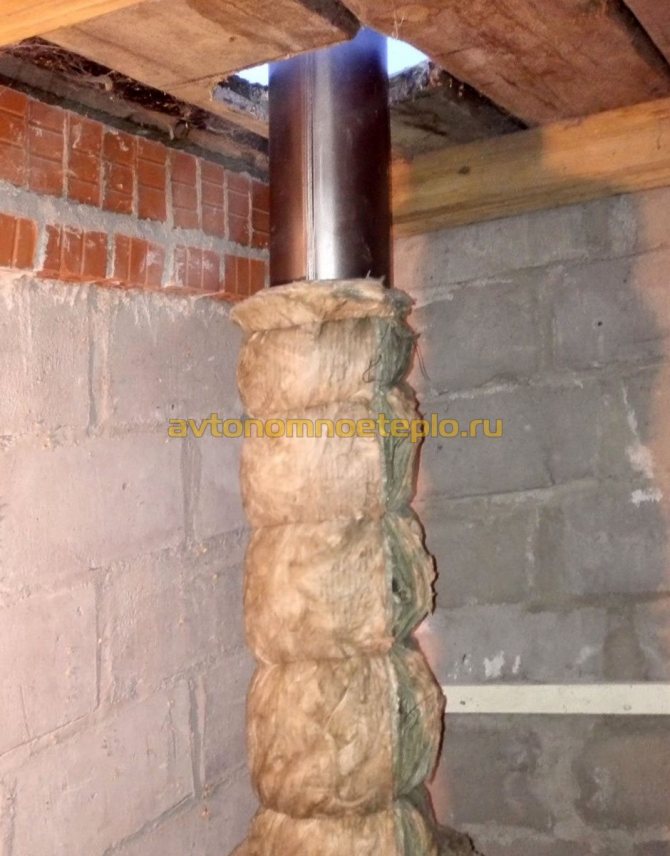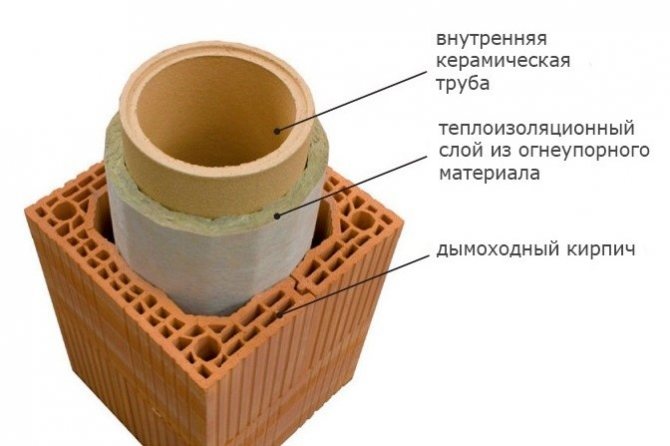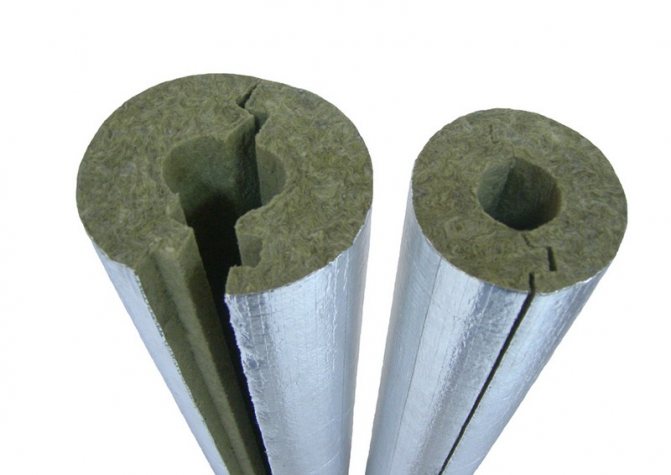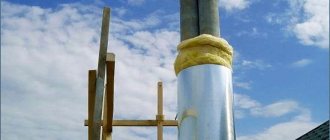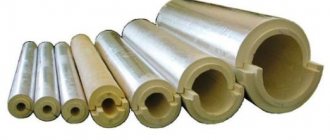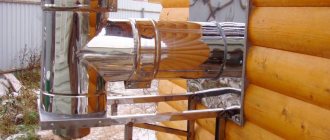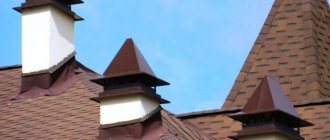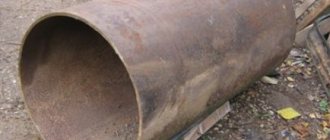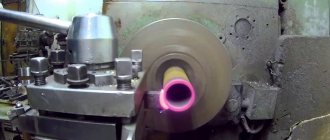Is it possible to use basalt insulation for a chimney
Basalt, used in the manufacture of chimneys, is one of the types of mineral insulation. Another name for the material is stone wool. Thermal insulation is made from gabbro-basalt rock waste. During the production process, the rock is crushed and melted, stretched into thin fiberglass.
The melting temperature in the furnace is 1500 ° C. The thickness of the pulled fibers is not more than 7 microns, the length is 5 cm. The resulting threads are passed twice through a press, preheated to 300 ° C. The resulting thermal insulation is distinguished by fire resistance, environmental friendliness, strength and other characteristics. It is not surprising that the largest manufacturers use fire retardant basalt insulation for chimneys.
Thermal insulation of the chimney with basalt wool, given the characteristics of the material, is quite justified. During the production process, the material acquires the following advantages:
- Low thermal conductivity - depending on the brand, the thermal insulation value of the material ranges from 0.032 to 0.048 watts per meter per Kelvin. Foamed rubber, expanded polystyrene, cork have the same characteristics.
- Hydrophobic - moisture settles on the surface and cannot get inside. Even in damp rooms or under the influence of atmospheric precipitation, stone wool retains its operational and thermal insulation characteristics. Therefore, the choice of basalt wool for insulation of a chimney installed outdoors is a really good solution.
- Fire resistance - basalt wool, without loss of strength, heats up to a temperature of 1114 ° C. At a higher temperature, the material begins to melt. This ability allows you to withstand even direct exposure to open fire. The chimney temperature, even when soot is ignited, does not exceed 1000 ° C, so basalt is suitable for insulating any flue systems, regardless of the principle of operation and the type of fuel used.
- Strength and resistance to subsidence - stone wool fibers are located both vertically and horizontally, which leads to the ability to withstand compressive loads from 5 to 80 kilopascals. During the entire service life, the material does not change its shape. Deformation is allowed no more than 10%.
Basalt wool for insulating chimney pipes is recommended for use in the manufacture of fire-prevention cuts, installation in wet rooms, as well as outdoor decoration.
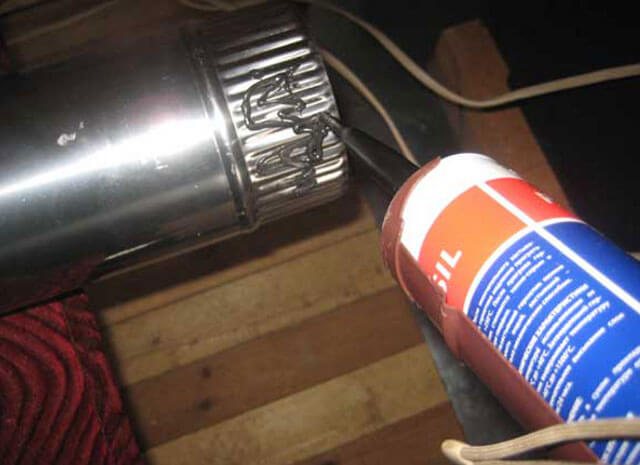
The characteristics of basalt fiber made it possible to significantly expand the scope of application, in comparison with conventional mineral insulation. In chimney systems, stone wool is used for the following purposes:
- Sandwich pipes - insulation of a steel chimney with basalt wool is carried out at the factory, which ensures high thermal performance and the absence of cold bridges. The construction of a sandwich pipe is distinguished by its light weight, heat resistance and good thermal performance.
- Ceramic pipes with a stainless steel outer sheath - 3-4 mm thick basalt wool cylinders are inserted into the structure. The absence of seams increases the already high thermal insulation characteristics. Ceramics installed in expanded clay concrete blocks are insulated during installation. You can wrap the chimney pipe with insulation with a thickness of 30/40/50 mm. Fix the cotton wool with clamps.
- Insulation of pipes of a single-wall steel chimney with basalt wool. For these purposes, it is recommended to use foil-clad basalt for the chimney.Foil stone wool reduces heat loss and protects the pipe from external influences of atmospheric precipitation.
- Insulation in penetrations - roof cutting for the chimney, as well as the passage in the floor slabs, in accordance with the requirements of PB and SNiP, is insulated with a non-combustible material. The gaps between pipes and structures are filled with stone wool. Fireproof foil-clad basalt insulation for chimneys is also used for the manufacture of fire-prevention cutting, protecting wooden elements of the building with it, located in the immediate vicinity of heating surfaces.
- Insulation of the chimney box - in order to prevent the appearance of oxides on brick channels, it is required to insulate the walls. For this purpose, rigid basalt slabs are optimal, allowing you to subsequently finish under plastering, laying ceramic tiles, etc.
Basalt is intended for thermal insulation of chimney pipes located inside and outside the building, for the manufacture of fire breaks and chimney passage nodes through structures.
The main mistakes in insulation
When performing chimney insulation, the following mistakes can be made:
- insulating material of insufficient thickness was laid, due to which the dew point was inside the chimney;
- leaks in the casing or insulation, which led to the appearance of condensation;
- non-compliance with the technology of laying the heat insulator;
- installation of insulation on an adhesive base that does not withstand high temperatures;
- the thermal expansion of materials was not taken into account, as a result of which the connecting seams were depressurized;
- a low-quality refractory insulation for the chimney was used, which does not meet the declared characteristics;
- the hardening time of putties, sealants or other materials has not been observed;
- installation is carried out in conditions of low temperatures or in case of precipitation;
- the base of the steel chimney for installation was not properly prepared, as a result of which it rusted and became unsuitable for further operation.
To avoid mistakes, it is necessary to strictly observe the insulation technology, control all stages of work and use exclusively high-quality materials. Quality control can be carried out in the following ways:
- Heat the oven up to 60% of its power and check the appearance of seam disconnections.
- Use a thermal imager to detect heat leaks.
Thermal insulation of chimneys is a relatively simple, but very profitable procedure, thanks to which the operating modes of the furnace will improve, heat loss will decrease, and fuel consumption will be reduced. The service life of the chimney will increase several times, while the need for frequent cleaning from ash will also cease to be a problem. The main thing is that the choice of material and installation method is correct.
Types of basalt insulation for thermal insulation of chimneys
The choice of a brand of basalt wool depends on the desired thermal performance. The material is selected depending on the features of operation, the type of chimney design. You will also have to decide on the appropriate insulation for the manufacture of roofing cuts and nodes of passage through the wall, and floor slabs.
Heat-insulating basalt chimney shells are used in industrial and domestic smoke evacuation systems. By wall thickness, they are subdivided into several grades: 55, 75, 90, 110, 150, 200. The shells are supplied in lengths of 1 meter each.
We suggest that you familiarize yourself with: Installation of chimneys from sandwich pipes instructions
When installing pressed basalt cylindrical insulation, they are guided by the requirements set out in SNiP 2.04.14-88, and specifically, by the following instructions:
- The cylinders have a longitudinal seam for easy installation on pipes. The insulation is fixed with bands made of thin sheet galvanized or stainless steel, with a thickness of at least 0.8 mm.Alternatively, stainless steel or black steel knitting wires are used, with diameters of 1.2 and 2 mm, respectively.
- Non-combustible basalt heat-insulating elements of the cylinders are installed at intervals along the seams. The joints are insulated with aluminum tape.
- Installation work starts from the flange. Foil insulation does not need a protective coating. In other cases, a casing or metal casing is made for insulation.
The use of basalt insulation in the chimneys of a sandwich system, in the form of heat-insulating cylinders, is limited to pipes with a flue gas temperature of no more than 300 ° C.
Basalt mats are used to insulate heated surfaces at temperatures from 450-700 ° C. Operation methods are regulated by GOST-16381. Insulation is selected according to the following parameters:
- Density.
- The type of cladding.
- One or two-sided material stitching.
- Operating temperature limit.


First of all, you need to pay attention to the declared density of basalt wool. For connection to solid fuel units, stone wool with a coefficient of 30-125 kg / m³ is suitable. The material does not have a covering layer and is able to withstand a constant working temperature of 700 ° C.
Non-combustible basalt insulation of high density, used in the manufacture of nodes of passage, as well as insulation of chimneys of any design.
For external and internal insulation of single-wall pipes, a basalt mat with foil is used. When installed inside a building, there is no need for a protective sheathing. The foil layer is connected to the insulation by means of stitching.
It is not recommended to use stitched mats for the wall duct of the chimney. It is possible to install mats for insulating ceilings at the place of passage of chimneys, making fire-fighting cuts.
One of the novelties on the market of heat-insulating materials is basalt fiber board. The main characteristics of basalt cardboard:
- With a small thickness, it has a high density and is able to withstand temperatures up to 900 ° C.
- It is used as refractory coatings during the installation of wood and solid fuel stoves, boilers.
- Resistant to vibration and moisture.
- Service life is not less than 50 years.
- Basalt cardboard thickness: 5/10/14/19 mm.
- The creation of multilayer structures is allowed to increase the thermal insulation properties.
It is quite simple to insulate a metal chimney by wrapping it in basalt foil cardboard. The material bends well around the circumference. After wrapping the pipe, the insulation is fixed with clamps.
It is allowed to insulate the chimney with foil-clad basalt cardboard for all types of flue systems. After installation, there is no need to make an additional protective structure.
The basalt shield is installed as a fire cut, protecting the wooden walls adjacent to the heating pipe.
How to insulate brick pipes
If you do not know how to insulate a brick chimney, we suggest using one of the following options:
- Application of plaster. This option is one of the simplest, fastest, most effective and affordable. The plaster must be applied to the pre-installed reinforcing mesh. In total, it is necessary to apply from 2 to 5 layers, depending on the thickness of the bricks. The total thickness of the plaster must be more than 50 millimeters. After the solution has completely dried, it must be carefully wiped off and applied to the surface 1-2 layers of chalk or lime paint;
- Mineral wool:
- On the inside of the pipe, a crate made of a metal profile is fixed;
- It is necessary to securely fix each guide with dowels;
- Insulation can be purchased both in rolls and tiled. The first option is the most convenient;
- Basalt wool must be fixed between the gratings.In this case, it is necessary to completely eliminate the occurrence of gaps;
- The next layer is to lay the vapor barrier;
- A plaster mesh is fixed, on which several layers of plaster are applied, in which cement should be present.
We offer you to familiarize yourself with Column foundation - calculation and advice on how to make the right foundation for a house
Thus, you can be one of the most convenient and suitable ways to insulate a brick chimney.
Basalt insulation brands for chimney insulation
Various manufacturers, the consumer are offered more than several dozen names of basalt heaters. Some are manufactured abroad, others at domestic enterprises.
Judging by customer reviews, the products of the following companies are popular:
- Basalt wool Rockwool is manufactured at the enterprises of the company of the same name, located in Denmark. In terms of its characteristics: hydrophobicity, sound and thermal insulation, as well as mechanical strength, Rockwool significantly outstrips analogues of other manufacturers. Basalt wool Rockwool is used by manufacturing companies for insulating finished ceramic chimneys Schiedel, Effe2 and others.
- Basalt wool URSA - originally made in Italy. Today the company has 14 large production centers located in Europe, the Middle East and Asia, which, as a result, could not but affect the quality of the products. The URSA company specializes in the insulation of industrial and domestic premises, and is popular due to the good price-quality ratio of its products.
- Izovat basalt wool is a heater made in the near abroad, in Ukraine. The product range includes mineral slabs with a density of 30 to 200 kg / m³. It is worth paying attention to a brand intended for insulating brick chimney ducts with subsequent plastering of the surface. The thickness of Izovat boards is from 30 to 200 mm.
- Paroc basalt wool is a Swedish company specializing in the production of stone wool since the 30s of the last century. Paroc production workshops are located exclusively in the EU countries, which allows maintaining a high level of quality and full compliance with safety standards in force in Europe. Paroc basalt cylinders can be used to insulate iron chimney pipes. To this end, the company has developed the Paroc Pro Section and Paroc Pro Bend cover layers, which provide maximum thermal insulation and protection for steel structures.
We suggest that you familiarize yourself with: How to impose a brick on a metal stove in a house: how to overlay a heating boiler, an iron stove, which brick is better to make
When choosing basalt for pipe insulation, it is mainly necessary to focus on the heat engineering characteristics specified by the manufacturer. On the basis of large concerns, modifications have been developed specifically for smoke extraction systems.
A little about installation
The procedure is so simple that the heating from polypropylene was not soldered, probably only the lazy one. To perform the work, you need the following tools and accessories:
- special soldering iron with a set of nozzles for different diameters;
- scissors for correct cutting of the pipe;
- a device with which the reinforcing layer of aluminum is cleaned when "stacked" pipes are mounted;
- cloth gloves.
Advice. Cloth gloves should not be ignored, especially for beginners. The soldering iron temperature reaches 300 ºС, and the heating surfaces are quite extensive. It is better to protect your hands so as not to get burned.
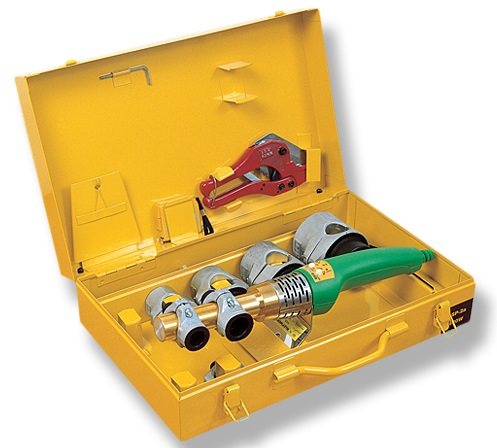

Soldering iron for connecting polypropylene pipes
Installation is carried out in the following sequence: first, pipe sections of the required length are marked and cut with scissors and laid out in accordance with the diagram. Before turning on, a nozzle of the corresponding diameter is attached to the soldering iron, or several nozzles at once. Since to connect polypropylene pipes it is necessary to use a soldering iron heated to a temperature of at least 260 ºС, it is better to turn it on and set it up in advance. The extinguished LED on the device will indicate that it is ready for use.
The joints on the pipe and fitting must be cleaned of dust and dirt, this is very important. If there is a reinforcing layer of aluminum, it will have to be removed using a special stripper for the length of the joint. Since welding of polypropylene pipes reinforced with fiberglass or basalt does not require cleaning, it is enough to simply wipe them off.
The next stage is the heating of the parts, for which the pipe and the fitting are put on the nozzle from both sides and kept for a certain time, depending on the diameter of the products. For size 20 mm this time is 6 sec, 25 mm - 7 sec, 32 mm - 8 sec and 40 mm - 12 sec. You cannot overexpose, otherwise the plastic will "flow" when docked and cover half of the flow area. Then the parts are removed from the nozzle and the polypropylene pipes are connected, holding the joint with your hands for 5-10 seconds.
Important! When removing parts from the soldering iron nozzle and subsequent docking, it is not allowed to rotate them around their axis.
Details of the pipe soldering process can be seen in the video.
Features of chimney insulation with basalt wool
In addition to the correct choice of basalt insulation, you need to worry about observing the installation rules. As practice shows, the following norms are especially often violated:
- The thickness of the layer of basalt wool in penetrations through wooden structures is at least 5 cm.The distance from the supporting beams is at least 1 m.
- If you need to lay the material in several layers, correctly lay out the fire-resistant basalt slab with an offset to overlap the joints of the lower sheet with the upper one. The same rule applies to the installation of a cylindrical insulation. The longitudinal seam of each subsequent shell is shifted 180 °.
- The device for the passage of the chimney through a wooden floor using basalt wool provides for the use of fire cutting. To combustible material, from the heating surface must be from 50-100 mm. The gap is filled with stone wool.
- The thickness of the basalt fiber in the chimney should be no more than 40 mm, for external insulation, up to 100 mm. The density is selected depending on the operating conditions. For insulation of ceramic chimneys connected to solid fuel boilers, basalt wool with a density of 100 to 200 kg / m³ is used.
- It makes no sense to use high-temperature basalt wool for thermal insulation of a chimney connected to a gas or oil-fired boiler, since the temperature of the flue gases rarely exceeds 200-300 ° C. Installation of a cylindrical insulation will be optimal.
- Calculation of the required amount of basalt wool for insulating a steel chimney. The required material thickness is selected. On the packaging of the insulation, the approximate consumption of cotton wool is indicated for different layer thicknesses. It remains to calculate the dimensions of the circle in centimeters and the length of the pipe. After that, the number of packages is calculated.
- After insulating a single-layer pipe with non-foil-clad material, it is imperative to manufacture a protective structure.
In some hardware stores, I can cut packages with basalt insulation in two, or sell mats individually. This allows you to purchase the exact amount of material and avoid overpayments.
The main disadvantage of basalt insulation is its cost. Otherwise, in comparison with any other types of thermal insulation, basalt undoubtedly wins. The advantages of the material include:
- Low thermal conductivity - even at an exhaust gas temperature of over 500 ° C, basalt wool heats up no more than 30 ° C. During a short-term ignition of soot and a temperature jump up to 900 ° C, the outer circuit of the sandwich pipe will not heat up more than 45 ° C.
- Non-combustibility - the material can withstand direct fire from a gas burner without igniting. Wool begins to melt after exceeding 1100 ° C.Therefore, you can lay the basalt insulation close to the chimney and not worry about the safety of the room during the entire period of operation.
- Easy installation - mats and sheets can be easily cut with a regular painting knife. The material is fixed with clamps or knitting wire. If you lay basalt wool with your own hands when installing chimneys, you can significantly save on work.
- The specific weight of even basalt refractory wool is 30 kg / m³, respectively, after insulation, the mass of the chimney structure does not increase much.
Basalt wool has no analogues in its characteristics and is the optimal solution when choosing a heater for a chimney. The only thing that limits the popularity of the material is the high cost associated with the peculiarities of the production process.
Non-combustible thermal insulation: insulation of brick, asbestos-cement pipes, stainless steel chimneys
The need to insulate high-temperature routes has arisen since their inception. And if the insulation of pipelines was solved quite simply - they were buried in the ground, then the insulation of chimneys caused a number of difficulties. And they were associated primarily with the danger of ignition of the heat insulator itself. That is why non-combustible heat insulation for chimneys is a priority in the choice of insulation.
Insulation of pipelines was solved quite simply - they were buried in the ground, then the insulation of chimneys caused a number of difficulties. And they were associated primarily with the danger of ignition of the heat insulator itself. That is why non-combustible heat insulation for chimneys is a priority in the choice of insulation.
For information! In some sources, you can read that such a layer is possible without reinforcement, but I still want to remind you that reinforcement is an element of reinforcement, and the layer that you leave will serve as a shield for the pipe, while taking it yourself on all temperature fluctuations, aggressive atmospheric influences. Therefore, the stronger the structure, the longer and without problems it will serve.
- Next is the application of plaster directly, which must be prepared in two consistencies: pasty and more liquid. A layer is applied one after another, the last is a thick layer, which is leveled and whitened with ordinary whitewash.
Also, basalt wool mats, foam glass and any other non-combustible heat-insulating material are suitable for a brick wall, while the technology will be as follows:
- The pipe is wrapped with insulation: either basalt wool mats (foam glass) are attached to umbrellas, or the roll is wrapped around the pipe and fixed with wire;
- Next, either another brick box is prepared around the pipe, followed by a hermetic filling of the gap between the main pipe and the casing, with cement mortar;
- Or the insulation is wrapped in foil, the lower docking part is cemented to form a cement pad, the joints and the seam part are closed with special foil tape.
insulation of brick pipes is as follows:
- At the end of all work, we need to get a layer of 5 cm, this will be quite enough for pipes, so we clean the pipe itself of dirt and unstable layers and reinforce it with a coarse-mesh metal mesh;
All the technologies we have described are quite simple, one might say economical, and easily do-it-yourself.
Pipes from the so-called stainless steel
For steel chimneys, the same materials are used as for asbestos-cement pipes. Laying technology, materials, fasteners, all this resembles the previous chapter. Only in this case there are ready-made solutions that you can choose and not suffer. These are the so-called sandwich systems, when the pipe is already in the pipe, and a non-combustible insulation is inserted between them.
General recommendations for work
Warming is a necessary process.
Whatever technology you choose for insulation, there are general recommendations that are lost, for some reason, in the general cacophony of advice, but which are still worth listening to in order to avoid many embarrassments. So:
- As you noticed, in all works, it is suggested to seal the lower edge in a cement base, before doing such work, make sure that the base of the roof allows them to be done;
- When carrying out insulation, keep in mind that neither the insulation nor the casing (if any) should come into contact with the roof. That is, it is necessary to think over the docking and drainage system;
- When purchasing glue mixtures for fixing the same basalt wool or foam glass, as well as adhesive tape for fixing heaters, pay attention first to the area of application, and then to the price, and not vice versa. The fact is that heat-resistant materials will initially be more expensive than conventional ones;
- When choosing a thermal insulation material, consult your dealer about the possibility of using the material. Although the material is delivered with the expectation of your region, sometimes a thinner insulation is stale. Just keep in mind that for insulation work, a material of at least 40 mm is required;
- More complete information can be in the accompanying documents for the material, as well as on the packaging, the official website of the manufacturer, do not be lazy to look at the information.
Stove heating with a pipe through which smoke from fuel combustion comes out is one of the most common in private houses. With the development of technologies, new heating systems appear, but as before, when boilers and furnaces using hydrocarbon fuels are used, the combustion products are discharged through the chimney.
Chimneys can be either part of the heating stove, or be a separate structure connected to it or the boiler by pipes. Sometimes chimneys are even arranged on a separate foundation next to the house. In cold climates, they all need to be insulated with non-combustible materials.
The main parameters of heaters
Thermal conductivity
When choosing a heater, the main attention is paid to its most important parameter - thermal conductivity, which does not depend at all on the density of the material, as many mistakenly believe. Heaters of the same density, but made using different technologies, may have different heat conductivity.
The lower the coefficient of thermal conductivity, the more efficiently and better the selected insulation material keeps heat in the house.
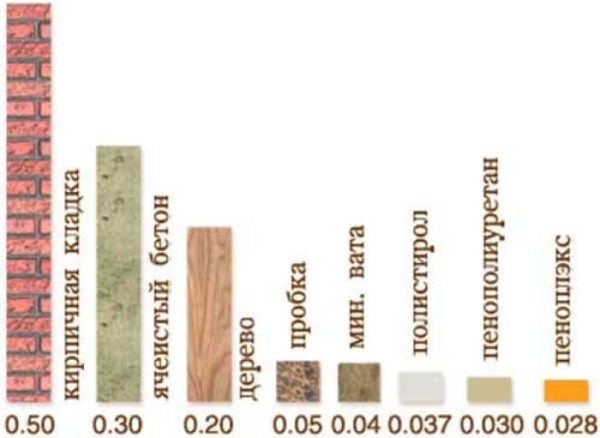

Coefficients of thermal conductivity of various materials (W / mK)
Water absorption
Another very important characteristic of an insulating material is the ability to absorb moisture. Water vapor is always present in the air. In a certain situation, it can turn into condensation inside the insulation, significantly reducing its thermal properties.
In this case, vapor barrier is required. This question becomes relevant if the loggia is also insulated.
Fire resistance
Insulation, like the entire structure of a house, especially a wooden one, must also have a fire-fighting property. This is especially important for insulating chimneys, fireplaces and other elements of the house, which are directly exposed to strong heating or direct contact with fire.
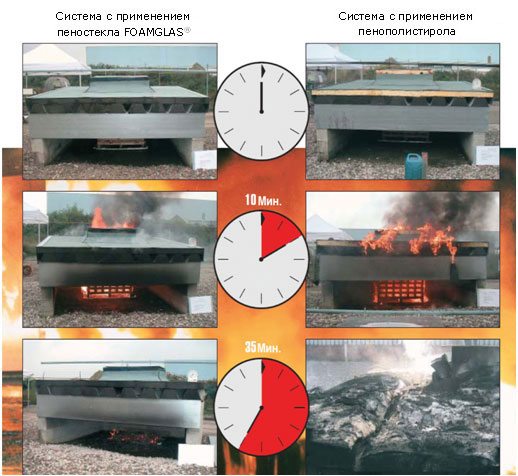

Comparative fire tests
Types of fire insulation
Mineral wool
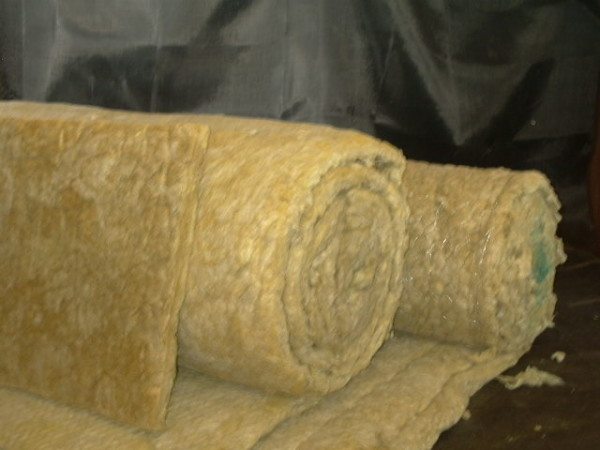

Photo of mineral wool
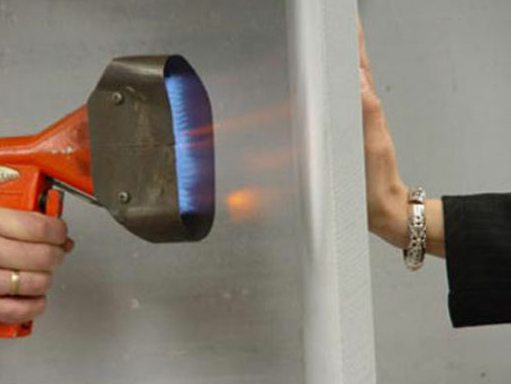

Mineral wool insulation is supplied in slabs or in rolls in the form of heat-insulating mats. Plates are more convenient and easier to use for insulation of roofs, floors and walls. Mats are more practical to use for pipes and various non-straight surfaces, as well as industrial equipment.
Cotton wool is made from sand, cullet, soda, and other components, which, after heating to a high temperature, turn into fiberglass. Then the material is impregnated with a special resin and pressed.
The most important advantage of mineral wool is its heat resistance. Cotton wool is a non-combustible insulation. Melting of the material begins when heated above 1000 ° C.
Therefore, such a fire-resistant insulation is effectively used by builders to insulate heat-resistant partitions, baths, chimneys and other structures.
Mineral wool insulation has also been used to insulate curtain walls and pitched roofs due to its excellent characteristics:
- low thermal conductivity;
- good sound absorption;
- high hydrophobicity (vapor permeability), which allows the building to breathe, thereby preventing the appearance of mold and mildew.
This refractory insulation consists of a layer of polyethylene foam, which is covered with polished aluminum foil on one side (or on both sides). It is a thin, very lightweight and completely environmentally friendly material with good flexibility.
Due to the low coefficient of thermal conductivity of foamed polyethylene, foil insulation is characterized by high resistance to heat transfer.
Polished aluminum foil is highly reflective. The reflection effect is up to 97%. Having the above properties, this type of insulation has excellent ability to reflect infrared (thermal) radiation, preventing heat loss to the outside.
Thanks to the use of foil insulation, energy costs for heating a building or room are significantly reduced. For this reason, it has found wide application for thermal insulation of hot (cold) water supply systems, heating systems, systems intended for air conditioning.
With its help, the interpanel seams and window openings are sealed. It is excellent for thermal insulation of floors and walls in both residential and public buildings.
Why is it important to insulate the chimney
The main reason for pipe insulation is to maintain the temperature inside the chimney. The fact is that for the normal operation of a boiler or furnace, good draft is required, at which a pressure difference is formed inside and outside the pipe. This, in turn, makes it possible to efficiently maintain the combustion and remove its by-products. To create a stable draft, the pipe must heat up quickly enough.
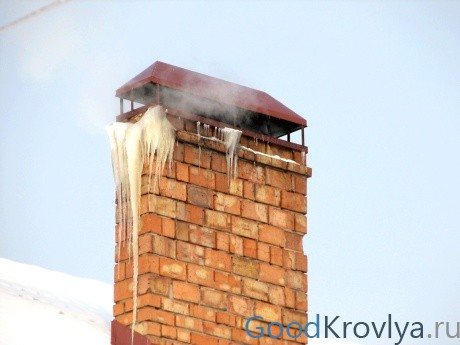

Chimney icing
In addition, the possibility of condensation should be minimized as much as possible. A heating boiler or stove is operated on an intermittent basis. They periodically turn off and on. At low ambient temperatures and the boiler is turned off, condensate that has formed in the chimney due to temperature differences settles on the walls of the chimney and freezes.
In the process of the subsequent switching on of the boiler, a situation is possible when the frozen condensate does not melt, and its layer will only increase. As a result, there may be a decrease in thrust due to icing.
Condensation also has a negative effect on the pipe. It consists in covering the walls of the chimney made of metal with corrosion or the penetration of moisture into the brickwork. It is worth considering that stainless steel is used for metal products, but in the process of exposure to temperature, humidity, as well as improper thermal insulation, the possibility of destruction is high.
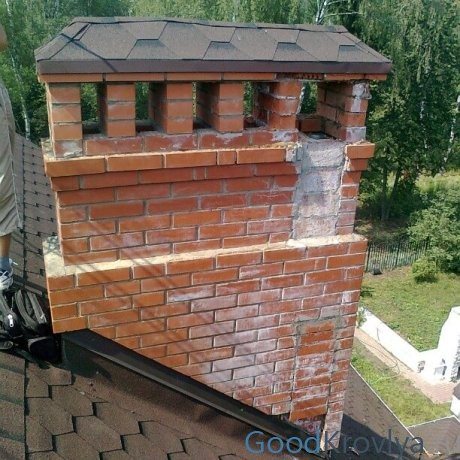

Condensation stains
It should also be noted that insulation fulfills the task of not only insulation, but also thermal insulation. This is important in conditions when the pipe runs close to building elements made of combustible materials. In this case, the contact temperature between the pipe and the material must be well below the ignition temperature.This result is quite achievable if you use insulation for the chimney, for example, from basalt wool.
Thus, insulated chimneys:
- reduce heat loss in the living space;
- minimize the formation of condensation on the surface;
- degrades more slowly and requires less maintenance;
- look more attractive;
- protect adjacent surfaces from the effects of high temperatures and condensation: roof, walls, ceilings.
